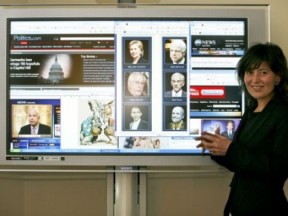In July this year, the Editor of Mint, R Sukumar, created a bit of a flutter when he wrote of an anchor with a business news channel who got three times her earlier salary, for agreeing to leave the top two buttons of her shirt unbuttoned, after switching jobs. Sukumar admitted that the column was all about losing friends and offending people, and maintained a diplomatic tone throughout.
But did he have a point?
Maybe. But a study conducted by two Indiana University researchers recently found that women looking to break through the glass ceiling into senior broadcast news positions or more prominent on-camera roles in television may hinder themselves when they succumb to pressures to dress in a more sexually alluring manner. Their findings also support the concerns of many female journalists who have faced gender discrimination as they get older in a news industry that disfavours aging women anchors.
Mary Elizabeth Grabe, professor of telecommunications, and Lelia Samson, a doctoral candidate in the Department of Telecommunications in the College of Arts and Sciences, had their subjects watch newscasts that were the same except for one variable. In the first version of their experiment, the anchor “was dressed in a tight-fitting dark blue jacket and skirt that accented her waist-to-hip ratio… She also wore bright red lipstick and a necklace.” In the other, the woman wore “a shapeless and loose-fitting dark blue jacket and skirt,” and did not wear a necklace or lipstick.
They found that enhanced sexual attractiveness boosted men’s perceptions of her professionalism. Yet, when it came to assessing her competence for reporting on different kinds of news, men were not optimistic about her abilities to do a good job reporting on hard news topics. “We saw a classic gender divide on that,” Grabe says of their findings related to anchor credibility. “Men saw the sexualised anchor as less fit to report on hard news topics such as politics and economics than her unsexualised version. It might very well be hard for men to take sexually attractive women seriously.”
At the same time, women who evaluate the anchor do not differ across versions in rating her competencies. Interestingly, women remember more newscasts delivered by the more sexualised anchor. “We don’t know why that is,” says Grabe, who was herself a news producer before becoming a professor. “We think that women might feel a sense of competition with the sexualised version, so they pay more attention to her and what she’s saying.”
Comely female anchors, in fact, actually reduce the amount of information recalled by male viewers. The “sexier” the female anchors the more attention men pay, but the less they remember of what the news is about.
There’s a cause for concern here. Says Grabe, “Despite the television news industry’s focus on hiring young and attractive female anchors, the workplace environment they enter might very well be unfriendly. Being hired and fired—at least in part—for sexual attractiveness is unlikely to diversify avenues for professional development. Ultimately, this industry sensibility perpetuates a gendered rather than professional work environment for female journalists.”
Grabe and Samson did not get into workplace dynamics, but concluded that gender stereotypes exist at the audience reception end of news messages.
Among men, sexual attractiveness in a female anchor boosts perceptions of her professionalism, in general terms. Yet, when it comes to assessments of specific competencies for reporting on masculine news topics (e.g., war and politics), sexualisation emerges as a detrimental factor. In particular, sexual cues harden men’s perceptions of a woman’s ineptness to report on traditionally masculine story topics. Women seem to be immune to this effect. Sexualisation of the female messenger actually does not work.
Grabe-Samson, whose findings had been published in the Communications Research journal, explain this from the evolutionary psychology perspective that men are highly affected by visually delivered sex cues. Grabe says, “Human beings, and in this case men specifically, privilege visual processing when it competes with the verbal mode of communication. When confronted with sexual attractiveness cues in the visual modality and nonsexual news information in the verbal modality, men’s cognitive mechanisms favoured visual over verbal information processing. It appears that visual primacy might, in the face of a sexually appetitive cue, manifest in the Homo sapiens male to levels that demand close to full cognitive capacity. For females it can be seen, in the context of this study’s findings, as cognitive kindle that rallies resource allocation to processing verbal information.”
These findings build on a 2007 formative investigation which looked at the nature and extent of sexually appealing newscasters primarily on cable news programmes in the US. Overall, 62 per cent of segments contained journalists with “high” sex appeal, and these were predominately female. Specifically, these journalists were physically attractive, suggestively dressed open blouses, tight-fitting skirts), and filmed in ways that accentuated these features. Female newscasters on Univision’s Primer Impacto, who double as models on its website, always exhibited “high” sex appeal compared to 93 per cent of newscasters on MSNBC, 49 per cent on Fox News, and 39 per cent on CNN.
Sukumar had called business channels the worst offenders, and written, “I am going to go ahead and name the good ones. I have not seen any of NDTV’s channels do this, nor Times Now and CNN-IBN.” He left readers guessing there, and all evidence we have is either circumstantial, or just conjectures.
Nevertheless, these channels, that Sukumar had alluded to, may get the male eyeballs they crave for, but at the end of the show most of the men wouldn’t remember too much about the news content. And the sexualisation wouldn’t have made an impact on women.
In the first pic: Mary Elizabeth Grabe
Subir Ghosh is a New Delhi-based independent journalist and writer. He has worked with the Press Trust of India (PTI) and The Telegraph, and handled publications/communications for the Centre for Science and Environment (CSE), the Federation of Hotels and Restaurant Associations of India (FHRAI), and the Wildlife Trust of India (WTI). He specialises in Northeast affairs and is an advisory council member with the Centre for Northeast Studies (C-NES). He is the author of ‘Frontier Travails: Northeast – The Politics of a Mess’ published by Macmillan India, and has won two national awards in children’s fiction. His subjects of interest include conflict, ethnicities, wildlife, human rights, poverty, media, and cinema. He blogs at www.write2kill.in







